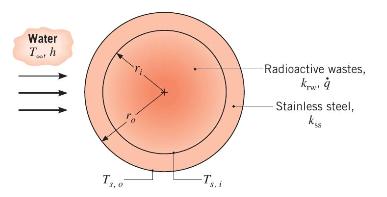Radioactive wastes (left(k_{mathrm{rw}}=20 mathrm{~W} / mathrm{m} cdot mathrm{K} ight)) are stored in a spherical, stainless steel (left(k_{mathrm{ss}}=15
Question:
Radioactive wastes \(\left(k_{\mathrm{rw}}=20 \mathrm{~W} / \mathrm{m} \cdot \mathrm{K}\right)\) are stored in a spherical, stainless steel \(\left(k_{\mathrm{ss}}=15 \mathrm{~W} / \mathrm{m} \cdot \mathrm{K}\right)\) container of inner and outer radii equal to \(r_{i}=0.5 \mathrm{~m}\) and \(r_{o}=0.6 \mathrm{~m}\). Heat is generated volumetrically within the wastes at a uniform rate of \(\dot{q}=10^{5} \mathrm{~W} / \mathrm{m}^{3}\), and the outer surface of the container is exposed to a water flow for which \(h=\) \(1000 \mathrm{~W} / \mathrm{m}^{2} \cdot \mathrm{K}\) and \(T_{\infty}=25^{\circ} \mathrm{C}\).

(a) Evaluate the steady-state outer surface temperature, \(T_{s, o}\).
(b) Evaluate the steady-state inner surface temperature, \(T_{s, i}\).
(c) Obtain an expression for the temperature distribution, \(T(r)\), in the radioactive wastes. Express your result in terms of \(r_{i}, T_{s, i}, k_{\mathrm{rw}}\), and \(\dot{q}\). Evaluate the temperature at \(r=0\).
(d) A proposed extension of the foregoing design involves storing waste materials having the same thermal conductivity but twice the heat generation \(\left(\dot{q}=2 \times 10^{5} \mathrm{~W} / \mathrm{m}^{3}\right)\) in a stainless steel container of equivalent inner radius ( \(r_{i}=0.5 \mathrm{~m}\) ). Safety considerations dictate that the maximum system temperature not exceed \(475^{\circ} \mathrm{C}\) and that the container wall thickness be no less than \(t=0.04 \mathrm{~m}\) and preferably at or close to the original design \((t=0.1 \mathrm{~m})\). Assess the effect of varying the outside convection coefficient to a maximum achievable value of \(h=5000\) \(\mathrm{W} / \mathrm{m}^{2} \cdot \mathrm{K}\) (by increasing the water velocity) and the container wall thickness. Is the proposed extension feasible? If so, recommend suitable operating and design conditions for \(h\) and \(t\), respectively.
Step by Step Answer:

Fundamentals Of Heat And Mass Transfer
ISBN: 9781119220442
8th Edition
Authors: Theodore L. Bergman, Adrienne S. Lavine





